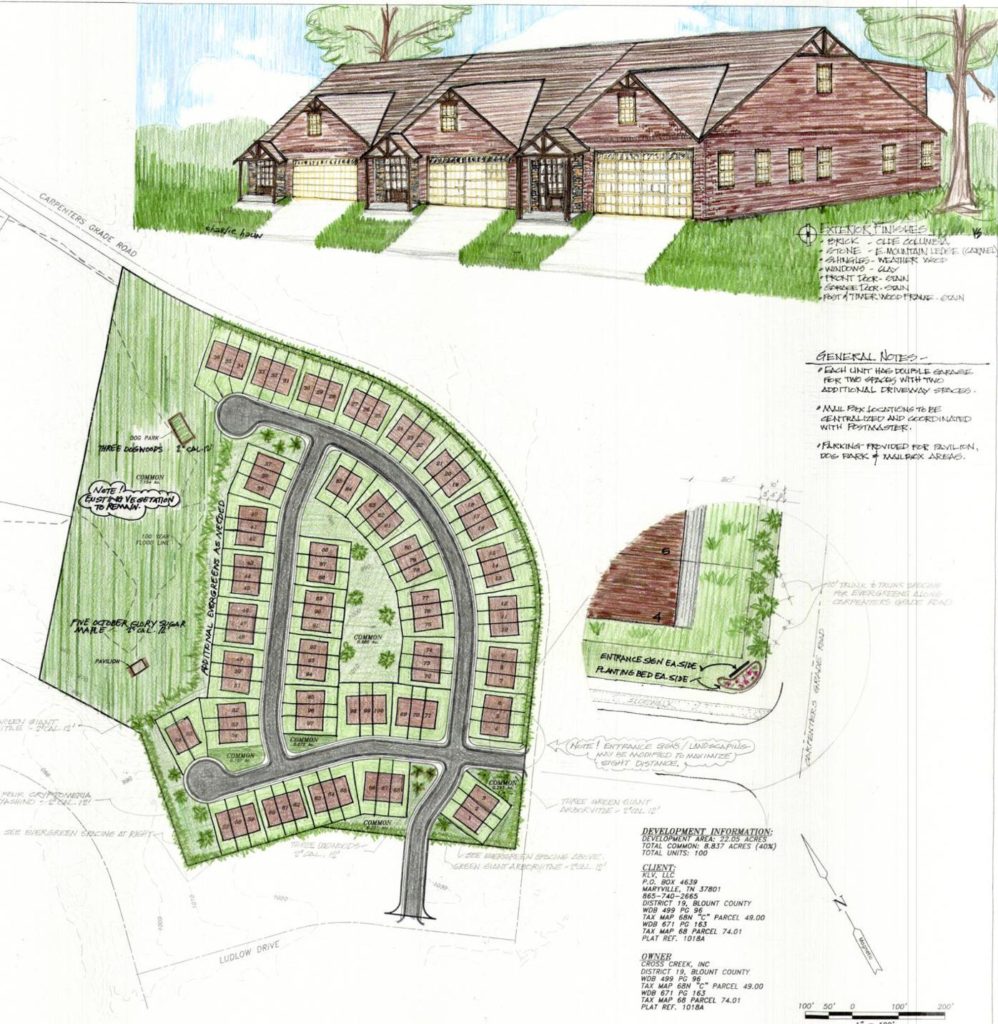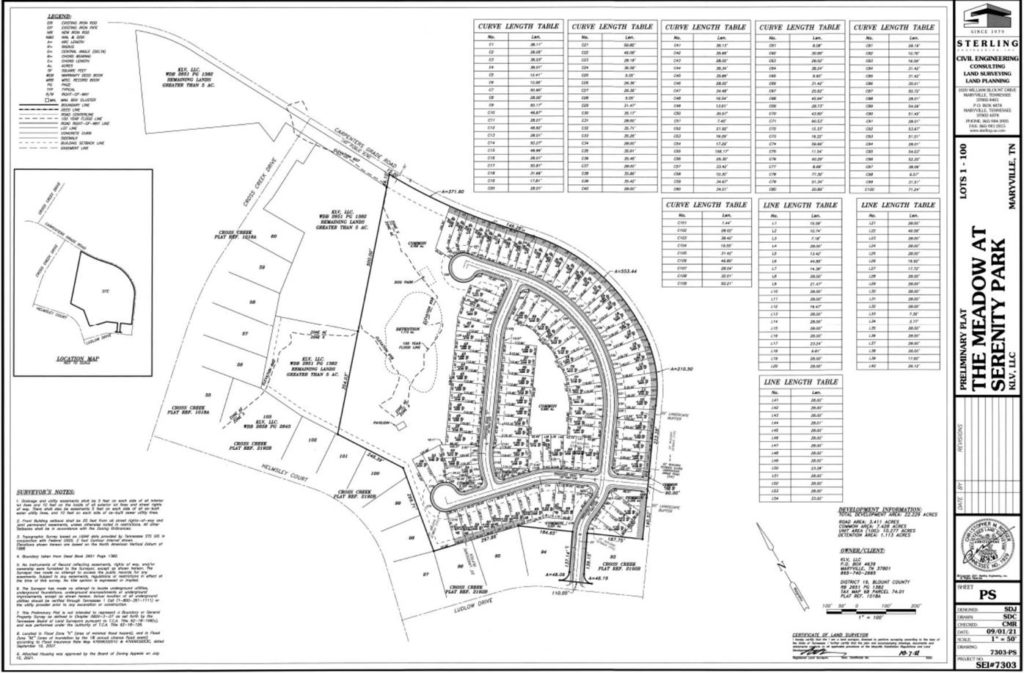Ad Hoc Decision-making Produces Poor Land Use Regulation
But it invites favoritism, promotes cronyism, and rewards insiders.

I appeared at the Maryville City Council meeting last night and made these remarks:
I’d like to comment on a subdivision project recently approved by the Maryville Planning Commission. The project, to be built on a 22-acre parcel adjacent to Cross Creek off Carpenters Grade Road, is called “The Meadow at Serenity Park.” It consists of 100 townhouse units comprising 34 structures. The land is zoned “residential,” which is supposed to be low-density single-family detached dwellings. On the Maryville zoning map, the property is shown in bright yellow, which connotes “R-1 E Low density Residential Exclusive.”
The development, as approved, is neither low-density nor consists of detached dwellings. According to the Daily Times, the townhouse project is being built only because “the Maryville Board of Zoning Appeals in July granted a special exception for the development.”
This decision strikes me as odd, for several reasons. Most of the neighborhoods surrounding this project are large, detached homes on half-acre (or larger) lots. Many residents in nearby subdivisions, especially Cross Creek, expressed opposition to the project. Traffic on Carpenters Grade (which becomes Sandy Springs) is already affected by Foothills Elementary to the north and residential development further south. This project will include an additional entrance onto Carpenters Grade.
But my main concern is a land use process that allows the incredibly detailed zoning ordinance—consisting of hundreds of pages of complex rules—to be overridden by granting a “special exception.” What is the point of designating a parcel as R-1 if the detached dwelling requirement can simply be waived? Most residents in the Cross Creek area bought their homes in the belief that zoning rules would dictate compatible development nearby. Building one hundred cookie-cutter attached townhouses on 20 acres is a density level out of synch with the existing neighborhoods. There are currently no townhouses in the vicinity of Cross Creek. Nearby homes are listed for close to $1 million. Undeveloped lots are listed for close to $100,000.
This project sticks out like a sore thumb. Many residents were and are chagrined that it was approved. Affordable, attached homes are appropriate in some areas, but not in Cross Creek.
Overdevelopment and disregard for zoning rules have generated significant controversy in Alcoa and unincorporated Blount County. I am disappointed that the City of Maryville has now joined the fray.

After my initial post, I received some additional information regarding the project. The addendum reflects the new information.
Addendum
The project now called “The Meadow at Serenity Park” has a long and contentious history.*
The dispute dates back to at least the 1990s, when a lawsuit (Case No. 94-018) was filed regarding sanitary sewer easements, connections, and construction on the parcel—then owned by an entity called Cross Creek, Inc. The caption of the case was City of Maryville v. Cross Creek Inc. and W. Keith McCord. For unknown reasons, the settlement of the case contained a stipulation that the subject property was not part of the Cross Creek subdivision. The case was resolved July 1996 in the form of an Agreed Final Order and Judgment (signed by Chancery Judge Chester Rainwater). To my knowledge, this decision was not appealed.
Years later, in 2005 or thereabouts, the owners (still Cross Creek, Inc.) sought a special exception from the Board of Zoning Appeals (BZA) to develop the 17 acres into attached townhouses/condominiums in a planned project called the “Village at Carpenter’s Grade.” The proposed project consisted of 76 or 77 units. The project was recommended by the city’s planning department. There was significant community opposition. On November 17, 2005, the BZA denied the request for a special exception on the grounds that “the project was not in harmony with the immediate neighborhood” (or, as stated in a different document, was “not in harmony with existing neighborhood”).** In January 2006, the owners filed a lawsuit challenging the BZA’s denial (Case No. 06-004).
On February 1, 2008, Chancery Judge Telford E. Forgety entered a Judgment and Final Order holding that the denial of the special exception was “arbitrary and in error” and ordering the BZA to issue the special exception permit (subject to some stipulations). It appears to me that the court’s ruling was premised on the belief that the BZA’s “sole and exclusive basis for the denial” was that the Cross Creek subdivision did not permit anything except single-family detached dwellings. The court referred to the 1996 ruling that the parcel was not part of Cross Creek and concluded (without considering whether a townhouse project was a compatible land use without regard to being part of Cross Creek) that the BZA had no valid reason to deny the special exception.
Despite what appears to be a confused and possibly erroneous decision, based on a poor record (the staff-prepared minutes of the November 17, 2005 BZA meeting are atrocious), I am not aware of any appeal. In 2008, the BZA approved the special exception per the court’s order.
In any event, the 2008 ruling became moot when—due to the recession—the project was delayed indefinitely and the deadlines for submitting a preliminary plat expired in 2012.
So matters stood until 2021, when the current owners of the parcel (KLV, LLC) submitted a plan to develop 100 townhouses on a 22-acre parcel, with the project named “The Meadow at Serenity Park.” KLV, LLC had bought the property from Cross Creek, Inc. (The principals of KLV are Jay Blevins and Randy Lamon. Randy Lamon is one of the owners of Lamon and McDaniel Builders.) Once again, the city’s planning department recommended approval of the project. At a BZA meeting on July 15, 2021, the five-member BZA voted to grant a special exception for this project, despite significant community opposition, with only member Clint Woodfin opposed. No traffic study was conducted prior to the BZA’s vote.
In support of its application for a special exception, KLV’s sole basis for establishing that “the proposed use will support the harmony and character of the area” was the conclusory statement: “Comparable to Cross Creek Subdivision.” This assertion is incorrect on its face; Cross Creek consists entirely of large detached homes on half-acre (or larger) lots. The special exception was sought to permit construction of 100 townhouses on a 22-acre parcel.
Despite KLV’s unconvincing assertion–on a required element for which it carried the burden of proof per Section 14-204(10)–the city planning staff recommended the special exception, on the basis of a perfunctory “analysis” of the two principal elements required for a special exception: (i) no damage to adjoining property values, and (ii) the proposed development is in harmony with the area in which it is to be located. The staff report to the BZA stated, without the benefit of any evidence or reasoned analysis, that “Staff believes the proposed development should not substantially injure the value of adjoining property,” and
Although there are no attached developments in the immediate area of the site, the development has separate access from the single-family subdivision to a collector street and is separated and screened from single-family dwellings with existing and proposed vegetation. Staff is of the opinion that, as proposed, the proposed development is in harmony with the area it is to be located. (Emphasis added.)
According to the meeting minutes, the Maryville City Attorney made the following comment at the BZA meeting: “If the traffic and stormwater would have the same problems between the two different styles of housing [i.e., detached versus attached] then they are not reasons to deny the special exception request. She went on to say the board cannot condition the approval of the request.” This statement seems to be contrary to the language of Maryville’s zoning ordinance, which states that special exceptions may be denied if the proposed development will injure the value of adjoining properties or is not in harmony with the area in which it is located. The planning department is supposed to apply the same standard. Section 14-203(7). The ordinance (in Title 14) states as follows:
Section 14-204(9)(c)
[The BZA] may…deny the permit if it concludes…the development, more probably than not: …(ii) Will substantially injure the value of adjoining or abutting property, or (iii) Will not be in harmony with the area in which it is to be located…. (Emphasis added.)
Section 14-204(12)
…[I]n granting a special exception permit, the board of zoning appeals respectively, may attach to the permit such reasonable requirements in addition to those specified in this ordinance as will insure that the development in its proposed location: (i) Will not endanger the public health or safety, (ii) Will not injure the value of adjoining or abutting property, [and] (iii) Will be in harmony with the area in which it is located…. (Emphasis added.)
In October 2021, the Maryville Planning Commission approved the preliminary plat for the project following the BZA’s grant of a special exception.
I continue to question why the BZA granted a special exception for a dense townhouse project out of character with any of the adjoining developments, which consist of large detached homes on half-acre (or larger) lots. Camden Court, to which Mr. Blevins made reference as a “very comparable” project, is not an adjoining development and is wholly dissimilar to the houses in Cross Creek and adjacent neighborhoods. The construction of 100 $500-600,000 townhouses will surely reduce the value of the surrounding neighborhoods containing homes now valued at close to $1 million.
The BZA–then consisting of Charles Blackburn, Hugh “Marty” Calloway, Barbara Crowder, Fred Metz, and DeDe Christopher–got it right in 2005 when it denied a special exception. The only thing that changed in the intervening 16 years is that the proposed project got bigger, ownership of the property changed hands, the local chancery court issued an erroneous decision in 2008 in a case involving a prior project, and the composition of the BZA changed. This is an unforced error on the part of the BZA, which currently consists of these members: Gary Best, Mike Brown, Clint Woodfin, Suzette Donovan (Chair), and James Tomiczek. Woodfin, it will be recalled, cast the only “nay” vote at the July 15, 2021 BZA meeting at which the special exception was granted to KLV, LLC.
The only constant from 2005 to the present is the unremitting support of the project by the Maryville Planning Department via favorable recommendations per Section 14-204(11). When a developer seeks a zoning change or special exception, per Section 14-204(7)(c) the planning department notifies property owners within 150 feet of the proposed development,*** which presumably defines the relevant portion of the neighborhood affected by the proposed development. At the July 15, 2021 BZA meeting, however, planning department staff cited the existence of attached dwellings a half-mile away in support of the conclusion that “the proposed project will be in harmony with the area [in which] it is to be located.” If the relevant “area” is a half-mile radius, why does the planning department staff only notify property owners located within 150 feet of the project?
The staff is obviously trying to have it both ways: defining the affected community narrowly for purposes of notice, but then taking a much broader perspective when evaluating whether the project is “in harmony with the area.” If the “relevant area” is up to a half-mile away, notice should have been given to all property owners in that area. Also, the planning department staff offered no data or analysis in support of its assertion that “the proposed project will [not] substantially injure the value of the adjoining or abutting property.” Plopping 100 cookie-cutter townhouses in the middle of a neighborhood consisting of large detached homes situated on half-acre (or larger) lots, some of which are currently on the market for nearly $1 million, will inevitably harm the value of existing homes in Cross Creek and surrounding developments. It is simply laughable to contend otherwise. Certainly the project itself supports “a reasonable conclusion” in this regard, which would warrant denial of the special exception. Section 14-204(10)(b).
* I have reconstructed the history based on a chronology of events provided by the Chair of the Maryville Board of Zoning Appeals, and a review of certain publicly-available documents. I have not researched the court files to review the underlying pleadings.
** I have surmised certain conclusions based on a review of publicly-available documents but have not thoroughly researched the underlying records. My assumptions may be incorrect.
*** I rely here on the chronology of events provided by the Chair of the Maryville Board of Zoning Appeals.































